Sesquicentennial
History, part 4
No Longer
a Frontier Church, 1873-1921
The changes overtaking First
Congregational Church in the years following the Civil War were
many. Some of these changes occurred within the congregation
itself. In 1873 Luther Clapp resigned to become General
Missionary of the Milwaukee Congregational Convention, a position
in which he aided a number of weaker churches in the region. He
left a strong church but one that would not again experience a
pastorate of a decade or more until the twentieth century (see
Appendix for List of Ministers). All the while, the community
around the Church was growing, and changing. By the 1870s
Wisconsin was no longer the frontier and Wauwatosa ceased to be a
farming community and more and more assumed its current role as a
suburb of Milwaukee.
Growth in Wauwatosa meant
growth in the congregation of the Church that required
accommodation. In 1870 a lecture hall had been added to the rear
(west) of the Church.
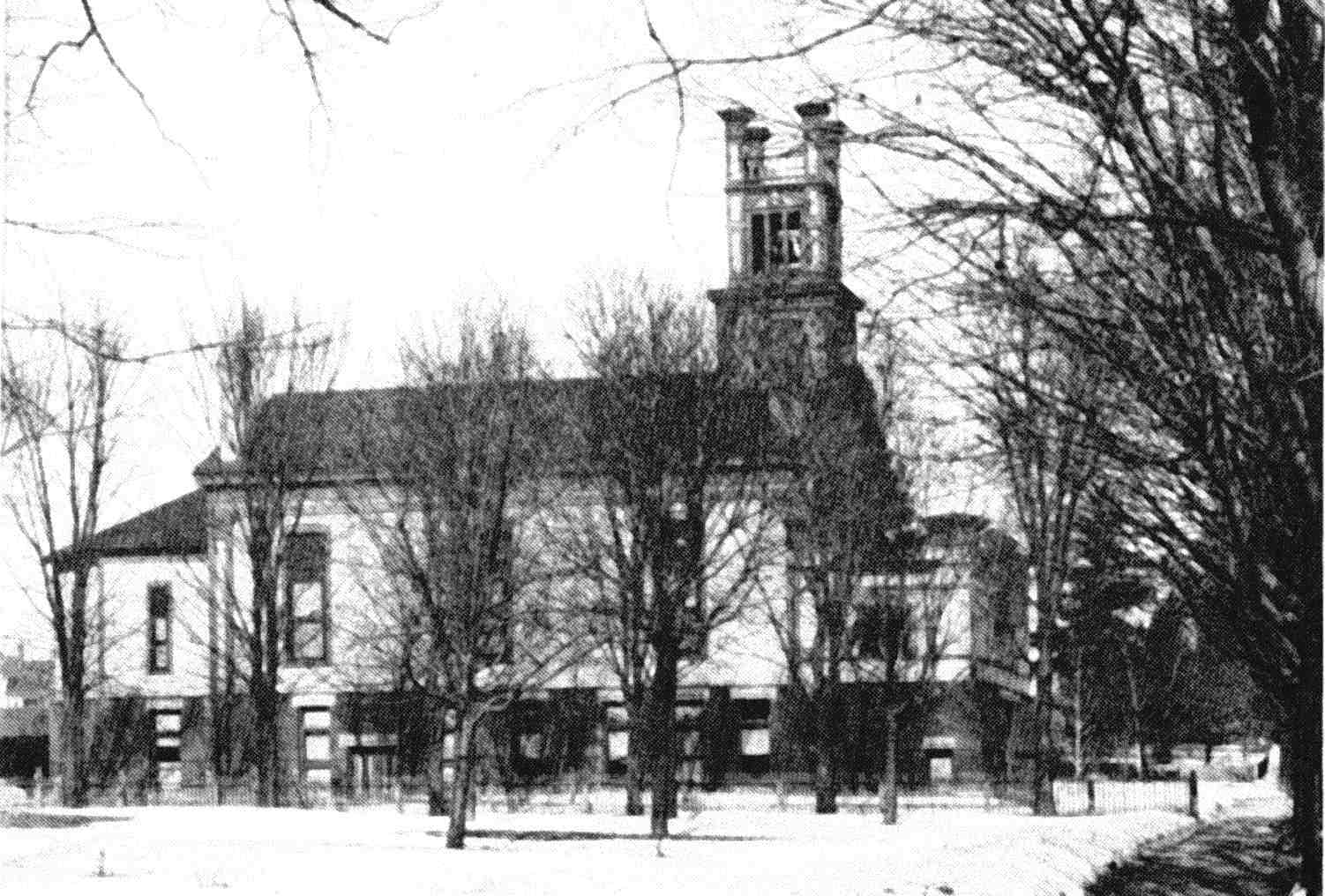 Built at a cost of $2,076.29, it was
entered through doors on either side of the front of the
sanctuary. Additional growth led to further expansion of the
Church's physical plant. A parsonage was constructed for $2,200
in 1884 opposite the Church. In 1888, at a cost of about $8,000,
the original Church building was raised and a "good
basement" constructed. A vestibule was added to the front
(east side) of the church, red-cushioned
Built at a cost of $2,076.29, it was
entered through doors on either side of the front of the
sanctuary. Additional growth led to further expansion of the
Church's physical plant. A parsonage was constructed for $2,200
in 1884 opposite the Church. In 1888, at a cost of about $8,000,
the original Church building was raised and a "good
basement" constructed. A vestibule was added to the front
(east side) of the church, red-cushioned
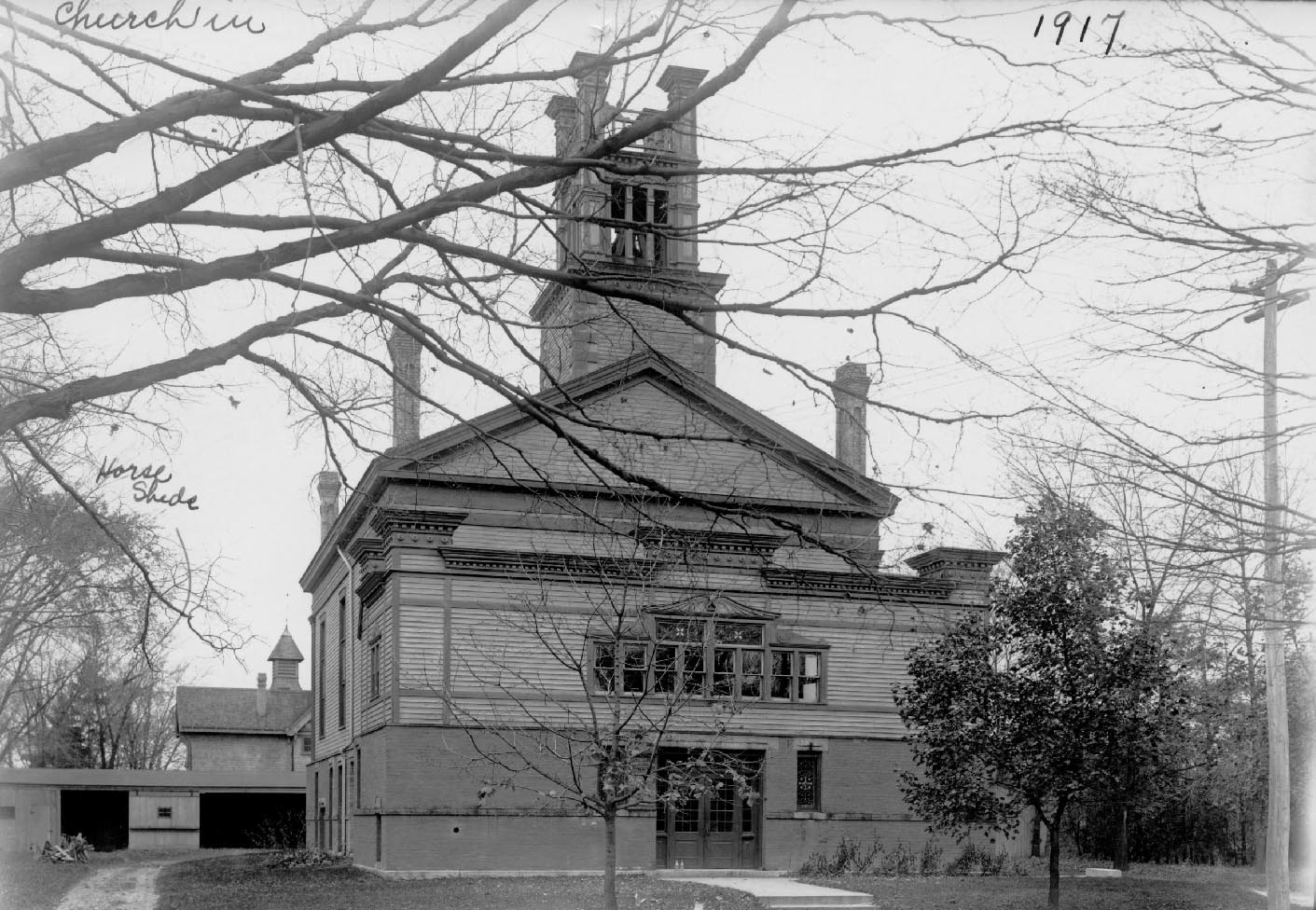 theatre seats replaced
the original pews, and a space was provided for the eventual
placement of an organ behind the pulpit.
theatre seats replaced
the original pews, and a space was provided for the eventual
placement of an organ behind the pulpit.
(NOTE: Three views of the 1888 church: side, front, and the Nave internals with the Organ
installed)
Such renovation
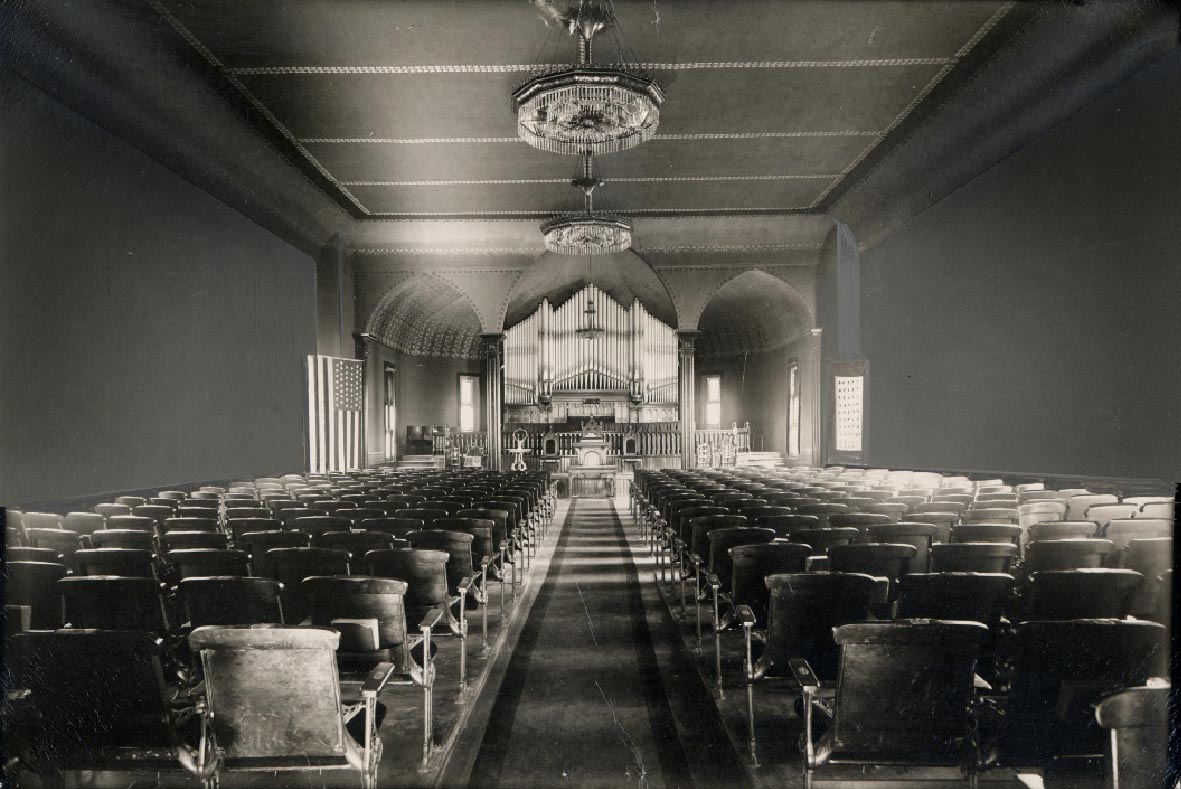 of the original
building, however, still failed to meet the needs of a growing
congregation. At the annual meeting in 1911 a sinking fund was
established for a new building, and the Church's seventy-fifth
anniversary, although observed on the brink of World War I on
March 1, 1917, provided the opportunity to accelerate fund
raising for a new church. With the end of World War I,
construction became possible. The last services were held in the
original Church on July 20, 1919 because the new Church was to be
built on the site of that structure. For several months, the
congregation was without a home: it held joint services with the
Methodists, who also were building a church, in the
of the original
building, however, still failed to meet the needs of a growing
congregation. At the annual meeting in 1911 a sinking fund was
established for a new building, and the Church's seventy-fifth
anniversary, although observed on the brink of World War I on
March 1, 1917, provided the opportunity to accelerate fund
raising for a new church. With the end of World War I,
construction became possible. The last services were held in the
original Church on July 20, 1919 because the new Church was to be
built on the site of that structure. For several months, the
congregation was without a home: it held joint services with the
Methodists, who also were building a church, in the
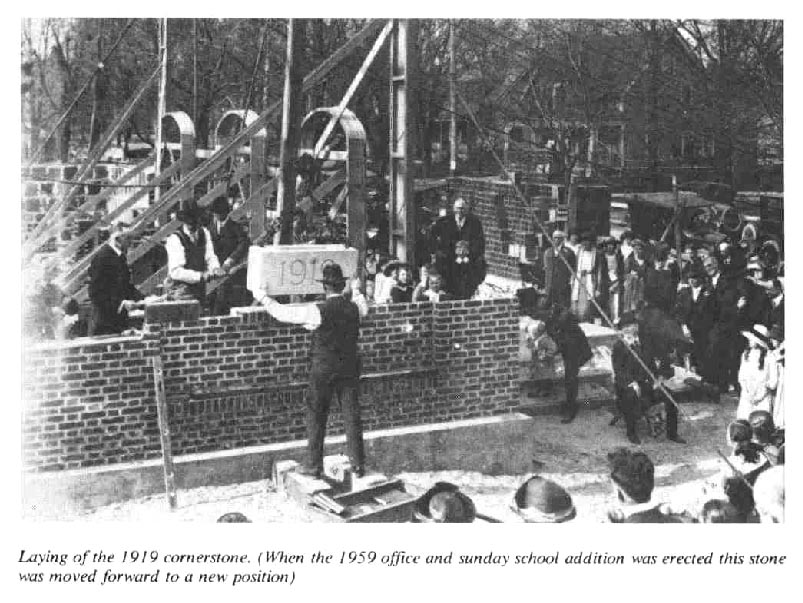 Masonic
Temple through August 17, 1919; and then the congregation held
Sunday afternoon services in the basement of Underwood Baptist
Church.
Masonic
Temple through August 17, 1919; and then the congregation held
Sunday afternoon services in the basement of Underwood Baptist
Church.
Finally, the Congregation
leased the lot on the southeastern corner of Church Street and
Milwaukee Ave. and there constructed, with donated materials and
the congregation's labor, led by the example of its minister
Howell Davies, a structure known as "The Tabernacle"
that was used for services from November 1919 through May 1921.
On May 20-23, 1921 the Church
dedicated its new sanctuary. Designed by architect E.E. Kuenzli,
a Church member, the building and its furnishings represented an
investment of $118,258.04 funded in part by a mortgage of
$38,650.00 on the Church and parsonage. This sanctuary, presently
still in use,
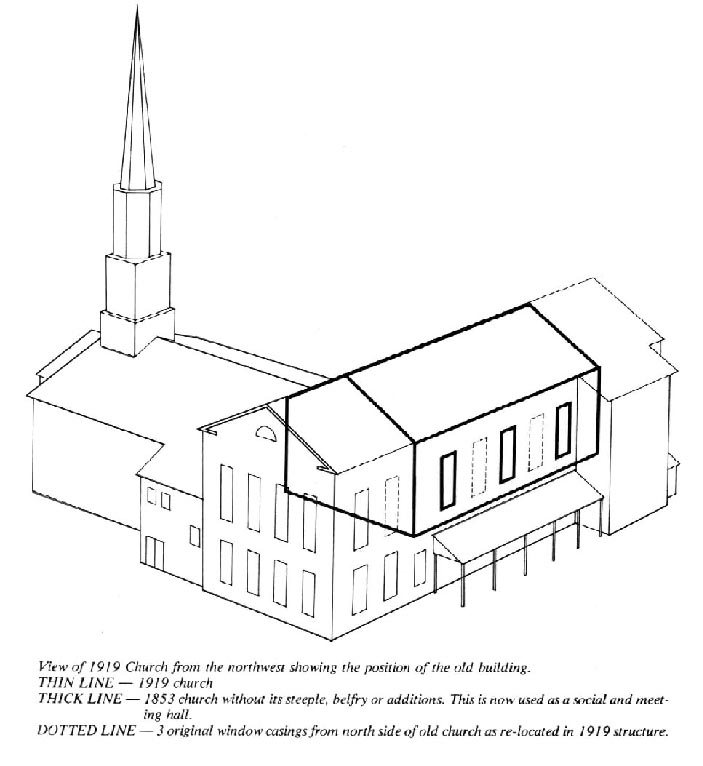 was connected to the original structure which had
been turned ninety degrees
was connected to the original structure which had
been turned ninety degrees
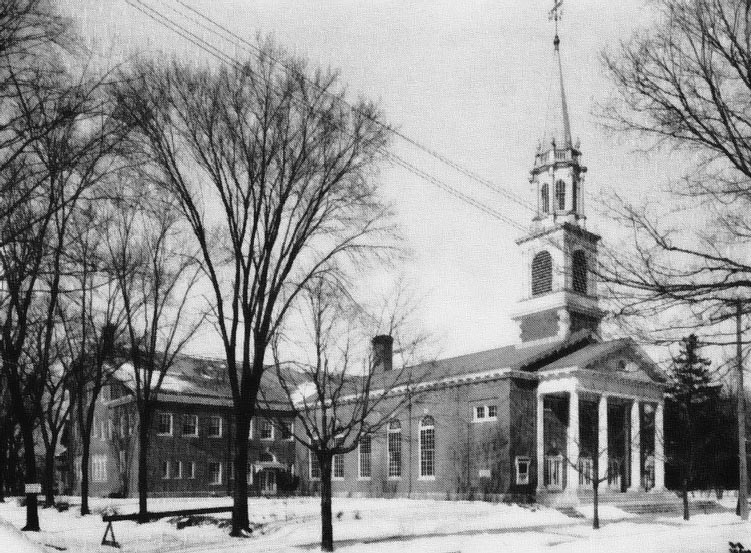 and moved back on the Church grounds
to form a wing for Sunday School classrooms and recreation
facilities.
and moved back on the Church grounds
to form a wing for Sunday School classrooms and recreation
facilities.
The activities of the
congregation in the late nineteenth and early twentieth
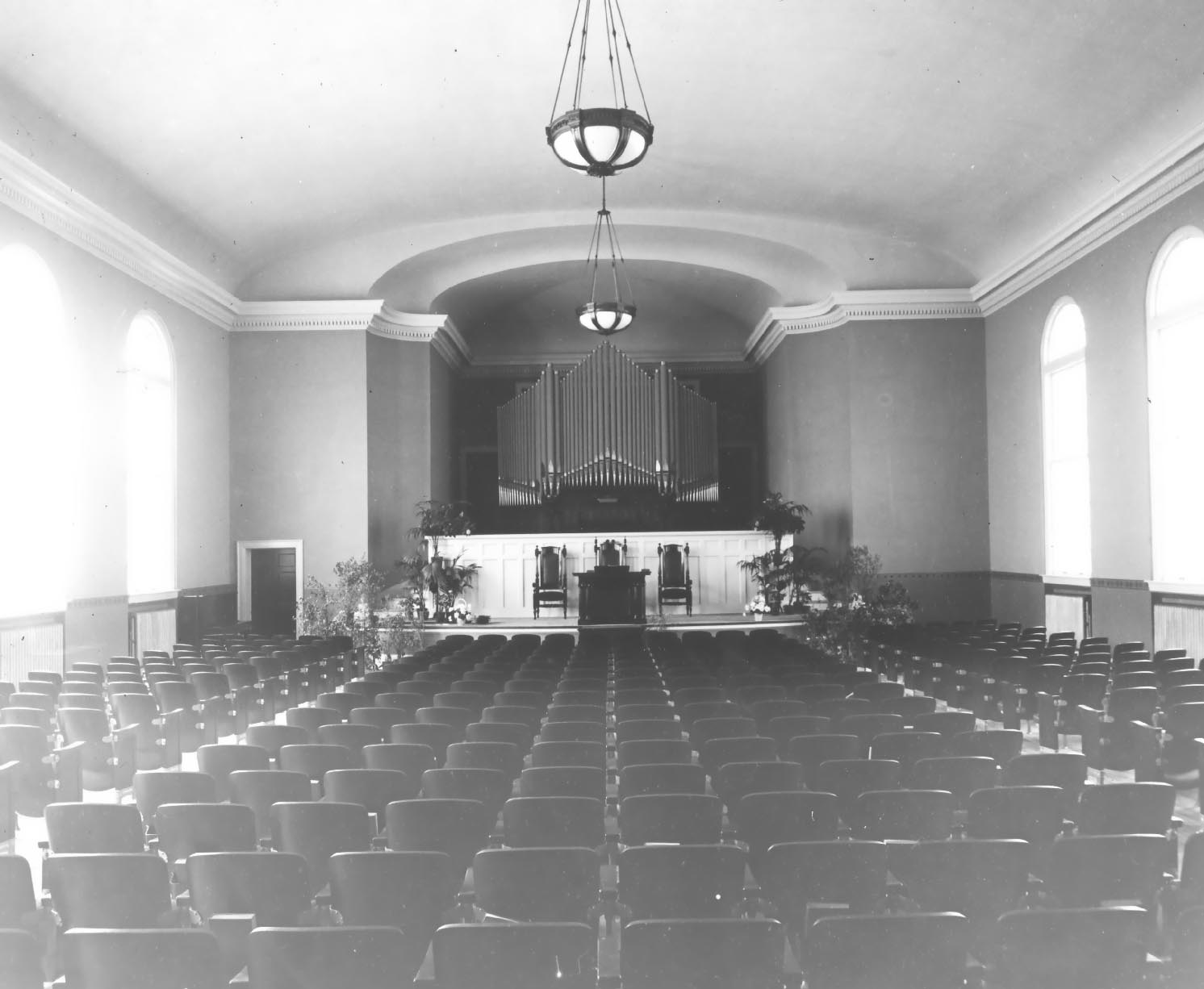 centuries
were numerous because this church, like so many others of the
period was really the center of its members' social as well as
religious lives. Church benevolence grew in size and scope of
interest, and by its fiftieth anniversary the Church had
contributed $23,526.97 to such worthy causes as Beloit College
($13,100), Chicago Theological Seminary ($900), Ripon College
($200) and missions ($9,326.97).
centuries
were numerous because this church, like so many others of the
period was really the center of its members' social as well as
religious lives. Church benevolence grew in size and scope of
interest, and by its fiftieth anniversary the Church had
contributed $23,526.97 to such worthy causes as Beloit College
($13,100), Chicago Theological Seminary ($900), Ripon College
($200) and missions ($9,326.97).
The various nineteenth-century
women's groups merged into the Women's League in 1907 and that
body first divided into circles in 1921. Women also participated
in the Daughters of the Tabernacle, a group meeting in the
evenings that drew its name from the Church's temporary place of
worship, and the World Fellowship Council interested particularly
in missionary work. Indeed, interest in missions was great and
several women of the Church went into missionary work, including
Sarah Clapp Goodrich who worked in China. Women's groups,
particularly the League, did much other important work for the
Church, financing Weekday Bible School with their fund raising,
running the Junior Choir and the Nursery, staffing a Hospitality
Committee to contact potential new members and visit shut-ins,
and providing meals for important Church events.
Youth activities assumed
increasing importance in the life of the Church in this period.
The focus of youth activities in the late nineteenth century and
the first years of the present century was the Young People's
Society for Christian Endeavor, an international,
interdenominational Christian Youth group founded in 1881. It was
supplanted in First Congregational Church in 1925 by the Pilgrim
Fellowship. Ministry to the youth of the community was further
enriched by the opening of Weekday Bible School in 1923. In this
endeavor, the Church was something of a leader. After his arrival
in 1925, the Reverend Henry James Lee prepared lessons for this
program which were used for a time by the majority of Milwaukee
area churches conducting such programs. Today, in 1992, First
Congregational Church's weekday program remains as one of the few
such programs in the metropolitan area.
As the First Congregational
Church changed, so did much around it. America became an
urbanized society in the early twentieth century, and the
automobile, as a former Church member from the era, Thomas
Kraseman, recalled, brought a personal mobility that spelled the
end of the Church's primacy in social life. Congregationalism
itself was also changing in very significant ways.
Developments in American
Congregationalism in the late nineteenth and twentieth centuries
certainly reflected developments in American Protestantism as a
whole. There was a growing desire among many for Christian unity
and for centralization of denominational activities. Many would
find in such trends increasingly disturbing contradictions of the
Congregational Way.
American Congregationalists
founded the National Council of Congregational Churches (NCCC) at
an Oberlin, Ohio meeting in 1871. Delegates representing 3,300
congregations concurred that the NCCC was not established to
abridge "the scriptural and unalienable right of each church
to self-government and administration," but they went on to
state their desire "to cooperate with all the Churches of
our Lord Jesus Christ . . . It is our prayer and endeavor that
the unity of the Church may be more and more apparent, and that
the prayer of the Lord for his disciples may be speedily and
completely answered, and all be one . . ."
The Oberlin actions provided
the basis for increasing efforts at both centralization of
Congregational activities through the NCCC and a federation with
other Protestant groups. The NCCC in 1910 created a Commission of
Nineteen to coordinate and develop national budgets for
Congregational benevolence and in 1913 appointed a full-time,
paid General Secretary. Christian unity efforts continued at the
same time. In 1892 Congregational Methodist Churches in Alabama
and Georgia affiliated with the NCCC and in 1931 the NCCC joined
with the General Convention of Christian Churches to form the
General Council of Congregational Christian churches.
The almost five decades
encompassed in this period of our history culminated, therefore,
with a stronger First Congregational Church. Housed in a new
building and part of an increasingly urbanized America, the
Church, however, found itself also part of a religious fellowship
in which there was apparent tension between the traditional
independence of individual churches and the growing institutional
structure of denominational governance.
Next Page: The Challenges of the 20th Century
1921-1991
Back to History Page:
A
Sesquicentennial History

 Built at a cost of $2,076.29, it was
entered through doors on either side of the front of the
sanctuary. Additional growth led to further expansion of the
Church's physical plant. A parsonage was constructed for $2,200
in 1884 opposite the Church. In 1888, at a cost of about $8,000,
the original Church building was raised and a "good
basement" constructed. A vestibule was added to the front
(east side) of the church, red-cushioned
Built at a cost of $2,076.29, it was
entered through doors on either side of the front of the
sanctuary. Additional growth led to further expansion of the
Church's physical plant. A parsonage was constructed for $2,200
in 1884 opposite the Church. In 1888, at a cost of about $8,000,
the original Church building was raised and a "good
basement" constructed. A vestibule was added to the front
(east side) of the church, red-cushioned
 theatre seats replaced
the original pews, and a space was provided for the eventual
placement of an organ behind the pulpit.
theatre seats replaced
the original pews, and a space was provided for the eventual
placement of an organ behind the pulpit.



